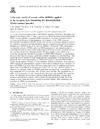Identificador persistente para citar o vincular este elemento:
https://accedacris.ulpgc.es/handle/10553/12825
| Campo DC | Valor | idioma |
|---|---|---|
| dc.contributor.author | Vallina, Sergio M. | en_US |
| dc.contributor.author | Simó, Rafael | en_US |
| dc.contributor.author | Anderson, T. R. | en_US |
| dc.contributor.author | Gabric, Albert J. | en_US |
| dc.contributor.author | Cropp, R. | en_US |
| dc.contributor.author | Pacheco Castelao, José Miguel | en_US |
| dc.date.accessioned | 2015-02-14T03:31:14Z | - |
| dc.date.accessioned | 2018-03-15T14:29:02Z | - |
| dc.date.available | 2015-02-14T03:31:14Z | - |
| dc.date.available | 2018-03-15T14:29:02Z | - |
| dc.date.issued | 2008 | en_US |
| dc.identifier.issn | 2169-8953 | en_US |
| dc.identifier.other | Scopus | - |
| dc.identifier.uri | https://accedacris.ulpgc.es/handle/10553/12825 | - |
| dc.description.abstract | A new one-dimensional model of DMSP/DMS dynamics (DMOS) is developed and applied to the Sargasso Sea in order to explain what drives the observed dimethylsulfide (DMS) summer paradox: a summer DMS concentration maximum concurrent with a minimum in the biomass of phytoplankton, the producers of the DMS precursor dimethylsulfoniopropionate (DMSP). Several mechanisms have been postulated to explain this mismatch: a succession in phytoplankton species composition towards higher relative abundances of DMSP producers in summer; inhibition of bacterial DMS consumption by ultraviolet radiation (UVR); and direct DMS production by phytoplankton due to UVR-induced oxidative stress. None of these hypothetical mechanisms, except for the first one, has been tested with a dynamic model. We have coupled a new sulfur cycle model that incorporates the latest knowledge on DMSP/DMS dynamics to a preexisting nitrogen/carbon-based ecological model that explicitly simulates the microbial-loop. This allows the role of bacteria in DMS production and consumption to be represented and quantified. The main improvements of DMOS with respect to previous DMSP/DMS models are the explicit inclusion of: solar-radiation inhibition of bacterial sulfur uptakes; DMS exudation by phytoplankton caused by solar-radiation-induced stress; and uptake of dissolved DMSP by phytoplankton. We have conducted a series of modeling experiments where some of the DMOS sulfur paths are turned “off” or “on,” and the results on chlorophyll-a, bacteria, DMS, and DMSP (particulate and dissolved) concentrations have been compared with climatological data of these same variables. The simulated rate of sulfur cycling processes are also compared with the scarce data available from previous works. All processes seem to play a role in driving DMS seasonality. Among them, however, solar-radiation-induced DMS exudation by phytoplankton stands out as the process without which the model is unable to produce realistic DMS simulations and reproduce the DMS summer paradox. | en_US |
| dc.format | application/pdf | - |
| dc.language | eng | en_US |
| dc.relation.ispartof | Journal Of Geophysical Research-Biogeosciences | en_US |
| dc.rights | by-nc-nd | - |
| dc.source | Geophysical research letters, American Geophysical Union [ISSN 2169-8953], v. 113 G1), G01009, (Marzo 2008) | en_US |
| dc.subject | 251007 Oceanografía física | en_US |
| dc.subject | 12 Matemáticas | en_US |
| dc.subject.other | Atlantic Time-Series | en_US |
| dc.subject.other | Dimethylsulfoniopropionate Dmsp | en_US |
| dc.subject.other | Solar-Radiation | en_US |
| dc.subject.other | Phytoplankton Community | en_US |
| dc.subject.other | Marine Dimethylsulfide | en_US |
| dc.subject.other | Biological Removal | en_US |
| dc.subject.other | Atmospheric Sulfur | en_US |
| dc.subject.other | Ecosystem-Model | en_US |
| dc.subject.other | Rapid Turnover | en_US |
| dc.subject.other | Gas-Exchange | en_US |
| dc.title | A dynamic model of oceanic sulfur (DMOS) applied to the Sargasso Sea: Simulating the dimethylsulfide (DMS) summer paradox | en_US |
| dc.type | info:eu-repo/semantics/article | en_US |
| dc.type | Article | en_US |
| dc.identifier.doi | 10.1029/2007JG000415 | en_US |
| dc.identifier.scopus | 2-s2.0-50549103512 | - |
| dc.identifier.scopus | 50549103512 | - |
| dc.identifier.isi | 000253066200001 | - |
| dc.contributor.authorscopusid | 13606163100 | - |
| dc.contributor.authorscopusid | 7102111067 | - |
| dc.contributor.authorscopusid | 7403303191 | - |
| dc.contributor.authorscopusid | 7003279098 | - |
| dc.contributor.authorscopusid | 55739684700 | - |
| dc.contributor.authorscopusid | 24741104100 | - |
| dc.identifier.absysnet | 551260 | - |
| dc.identifier.issue | 1 | - |
| dc.relation.volume | 113 | en_US |
| dc.investigacion | Ciencias | en_US |
| dc.rights.accessrights | info:eu-repo/semantics/openAccess | - |
| dc.type2 | Artículo | en_US |
| dc.contributor.daisngid | 2005009 | - |
| dc.contributor.daisngid | 372036 | - |
| dc.contributor.daisngid | 197507 | - |
| dc.contributor.daisngid | 593086 | - |
| dc.contributor.daisngid | 180511 | - |
| dc.contributor.daisngid | 5549935 | - |
| dc.description.numberofpages | 23 | en_US |
| dc.utils.revision | Sí | en_US |
| dc.contributor.wosstandard | WOS:Vallina, SM | - |
| dc.contributor.wosstandard | WOS:Simo, R | - |
| dc.contributor.wosstandard | WOS:Anderson, TR | - |
| dc.contributor.wosstandard | WOS:Gabric, A | - |
| dc.contributor.wosstandard | WOS:Cropp, R | - |
| dc.contributor.wosstandard | WOS:Pacheco, JM | - |
| dc.date.coverdate | Febrero 2008 | en_US |
| dc.identifier.ulpgc | Sí | en_US |
| dc.contributor.buulpgc | BU-BAS | en_US |
| dc.description.scie | SCIE | |
| item.grantfulltext | open | - |
| item.fulltext | Con texto completo | - |
| crisitem.author.orcid | 0000-0003-4027-8608 | - |
| crisitem.author.fullName | Pacheco Castelao, José Miguel | - |
| Colección: | Artículos | |
Citas SCOPUSTM
49
actualizado el 25-may-2025
Citas de WEB OF SCIENCETM
Citations
47
actualizado el 25-may-2025
Visitas
74
actualizado el 18-mar-2023
Descargas
149
actualizado el 18-mar-2023
Google ScholarTM
Verifica
Altmetric
Comparte
Exporta metadatos
Los elementos en ULPGC accedaCRIS están protegidos por derechos de autor con todos los derechos reservados, a menos que se indique lo contrario.
